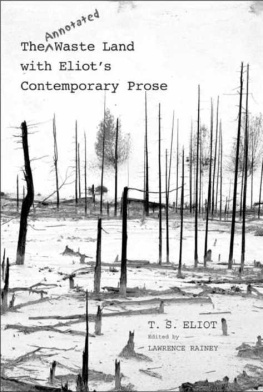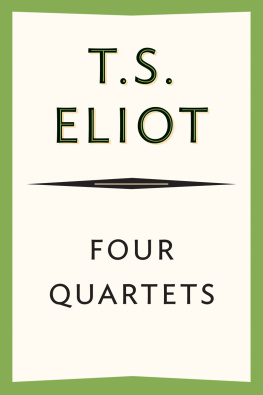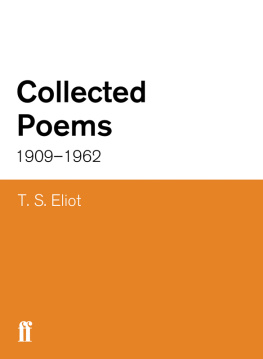REVISITING THE WASTE LAND
LAWRENCE RAINEY
Revisiting The Waste Land

Copyright 2005 by Lawrence Rainey.
All rights reserved.
This book may not be reproduced, in whole or in part, including illustrations, in any form (beyond that copying permitted by Sections 107 and 108 of the U.S. Copyright Law and except by reviewers for the public press), without written permission from the publishers.
Set in Scala by Duke & Company, Devon, Pennsylvania.
Printed in the United States of America.
Library of Congress Cataloging-in-Publication Data
Revisiting The waste land / Lawrence Rainey.
p. cm.
Includes bibliographical references and index.
ISBN 0-300-10707-2 (alk. paper)
1. Eliot, T. S. (Thomas Stearns), 18881965. Waste land. I. Title.
PS3509.L13W3639 2005
821.912dc22
2004017255
A catalogue record for this book is available from the British Library.
The paper in this book meets the guidelines for permanence and durability of the Committee on Production Guidelines for Book Longevity of the Council on Library Resources.
10 9 8 7 6 5 4 3 2 1
For Evan Rainey
who has a wicked backhand
CONTENTS
PREFACE
What are you thinking of? What thinking? What?
I never know what you are thinking. Think.
T. S. Eliot, The Waste Land
Think, pig! (Pozzo jerks the rope. Lucky looks at Pozzo.) Think, pig!
Samuel Beckett, Waiting for Godot
MORE THAN EIGHT DECADES after it was first published in 1922, The Waste Land has lost little of its lacerating power or its uncanny capacity to startle and disturb. Though it may never acquire a readership as broad as, say, that which currently follows the work of Stephen King, its status remains secure as the greatest long poem written in English in the twentieth century. And though too many readers first encounter the poem in a classroom setting that sometimes encourages a style of reading inimical to the poems grotesque and grim extremism, many others first encounter it through the prompting of simple curiosity, returning to it with pleasure again and again. In writing this book, I have attempted to address not just scholars of Eliots work but also that large body of nonspecialists who continue to take an intelligent interest in understanding a poem that has been so central to the culture of the twentieth century.
Readers under a certain age will not recall the enormous excitement produced in 1971 when Valerie Eliot, the poets second wife, published a facsimile edition of the poems prepublication drafts, typescripts, and other working materials (The Waste Land: A Facsimile and Transcript of the Original Drafts [New York: Harcourt Brace, 1971]). No book review section of the time was complete without an extended essay whose author tried to assess how the new materials altered our understanding of the poem. Reviewers generally agreed that the poems composition had been more troubled than one might have supposed, or that its evolution had been more tentative and confused than critical accounts of the poem might have led one to surmise. They got no farther than this elementary observation, however, because only a tiny proportion of the prepublication materials had been assigned tentative dates by Mrs. Eliot. The rest was a chaotic jumble.
In I take up this long-standing problem, one that has troubled critics and interested readers for more than thirty years. I do so by applying a method that is regrettably lacking in grand theoretical premises, one buttressed only by the everyday dictates of common sense. If we compare the papers that were used in the Waste Land manuscripts with those that were used in T. S. Eliots contemporaneous letters, we will have reasonable grounds for inferring the dates of the working materials that make up the Waste Land manuscripts. Dates by themselves, of course, are inert information, raw data; they must be integrated into the connecting tissue of analysis and argument that will enable us to organize them into a meaningful story: an account of how The Waste Land was composed, of the choices and impasses that Eliot faced as he wrote, and of the solutions that he adopted to address them. Discovering that story, in turn, enables us to appreciate more fully the distinctive aesthetics of the histrionic that Eliot was elaborating, both in the poem and in his contemporary essays (only recently republished after more than eighty years; see Lawrence Rainey, ed., The Annotated Waste Land with Eliots Contemporary Prose [New Haven: Yale University Press, 2005]), and so to read his poem in a key that differs sharply from most accounts of the last eight decades.
In I take up the poems publication history, an unusually protracted and complicated one. Our received myth is that the poem was either neglected or reviled in the 1920s after it first appeared. Quite the contrary: publishers who had read not so much as a word of the poems text competed fiercely with one another to bring it out, and the story of that competitionor rather, the story of what they thought they were competing forcan tell us much about how institutions shape the horizons of expectations that readers bring to a text. (This chapter, it should be noted, has been published in a previous collection of essays; but I have significantly revised and updated it here to take into account new information.)
Confronted with the poems intransigent opacity, and deprived of the numerous guides which have subsequently turned its enigmas into something as tidy as a schoolboys lunch box, readers and critics struggled in I identify the fault lines that ran through these early discussions and go on to consider reasons why it may be that The Waste Land will always prove resistant to the kind of account that most critics, simply by virtue of being human, want to give of it.
This book, in short, is not a systematic overview of The Waste Land, nor does it offer a line-by-line commentary or analysis. In it I take up three topics: the poems production, transmission, and reception, or how it came to be written, published, and read. And although I do introduce and summarize research that will be new even to scholars of Eliots work, I hope that I do so in ways that make it accessible also to anyone who takes an interest in Eliots masterpiece. Ideally, even a reader who has encountered the poem for the first time only recently should be able to turn to these pages with profit.
One last prefatory comment is in order. To discuss the large and disorderly body of manuscript materials which have come to be known as the prepublication manuscripts of The Waste Land, we need a few technical terms that can help us economically designate the various states that a text undergoes in the course of its production. One term is familiar to all of us: a draft is a tentative or provisional form of a text. Another term has somewhat less currency in everyday speech: a fair copy is a version of a text that has been prepared for a readership, even if that readership comprises only the author himself. Whereas a draft will typically have cancellations or alternative readings which show an author actively at work, a fair copy will typically be neatly written out in longhand or, if the author lived after the invention of the typewriter, in typescript. If the fair copy is written out by the author in longhand, it is called an autograph fair copy. That term is not meant to indicate that the author has signed it or otherwise appended his signature or autograph to it; instead it harks back to the Greek etymology of the word autograph: self-written. If, instead, the fair copy has been prepared with a typewriter, it is a
Next page




